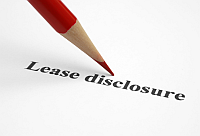If you are leasing a retail premises, you must provide your tenant with a Disclosure Statement at the start of the tenancy, to comply with the tenancy legislation.

Landlords are required by law to provide a prospective tenant with a summary or disclosure statement of all the important terms of the proposed lease.
The Disclosure Statement is essentially a summary of the most important aspects of the Lease.
On viewing the Disclosure Statement, the tenant should be able to quickly and easily ascertain the important terms of the lease, such as:-
- the rent;
- all increases in the rent over the term of the lease and any additional terms (option periods);
- all costs associated with renting the premises – any and all outgoings, charges and expenses that may arise under the lease;
- the length of the lease;
- any option periods available to the tenant under the lease;
- any obligation to fit-out, refurbish or undertake other work to the premises;
- the permitted use of the premises; and
- other relevant disclosures.
A Disclosure Statement helps tenants evaluate whether the lease is viable
Disclosure Statements are intended to assist potential tenants to make a fully informed decision as to whether it is viable to enter into a retail lease.
It brings important obligations that may be hidden to light
The Disclosure Statement helps bring important obligations that may be buried in the small print to light, providing the tenant with an easy to read summary of the most important and onerous aspects of the lease.
It offsets unequal bargaining power and resources
While not always the case, it is a relatively common scenario for landlords and tenants to have unequal bargaining position and for there to be a disparity of power, especially in the larger shopping complexes.
By introducing Disclosure Statements and other measures, the government seeks to level the playing field somewhat. The landlord (in most states) must also provide a government supplied information brochure to the tenant, which informs the tenant of their rights and responsibilities under the tenancy law.
Provides remedy for providing false or misleading information
The Disclosure Statement promotes openness and transparency on the part of the landlord. In fact, if the landlord provides a Disclosure Statement that is incomplete, false or misleading, then the tenant has rights to terminate the lease.
Our ready-to-use Retail Lease kit includes everything you need to rent your shop premises
- Professionally drafted retail lease Agreement (doc)
- Professionally Drafted Disclosure statement
- Sample disclosure statement and Retail lease
- Easy to follow help guide
- Getting Started document
- Friendly customer support
Need more resources?
Why honesty is so important when leasing a property
 Honesty between the Landlord and the tenant allows the tenant to make an informed choice about whether they will accept the lease.
Honesty between the Landlord and the tenant allows the tenant to make an informed choice about whether they will accept the lease.
How to Manage Outgoings in Commercial and Retail Lease Agreements
 When you lease a retail or commercial premises, you need to decide how you will manage the outgoings. Will they be charged as a separate amount or will they be added to the regularly monthly payment. This article helps you to determine which option you should choose.
When you lease a retail or commercial premises, you need to decide how you will manage the outgoings. Will they be charged as a separate amount or will they be added to the regularly monthly payment. This article helps you to determine which option you should choose.
Stating the Parties to a Contract correctly
 It might seem very basic, but it is vital to get the names of the entities or “parties” correct when drafting a legal document. Stating the parties formally and accurately gives you certainty that there can be NO question about the parties’ intentions later, especially if the particulars are changed or forgotten. We look at the different types of “parties” and the correct way to record the information.
It might seem very basic, but it is vital to get the names of the entities or “parties” correct when drafting a legal document. Stating the parties formally and accurately gives you certainty that there can be NO question about the parties’ intentions later, especially if the particulars are changed or forgotten. We look at the different types of “parties” and the correct way to record the information.

